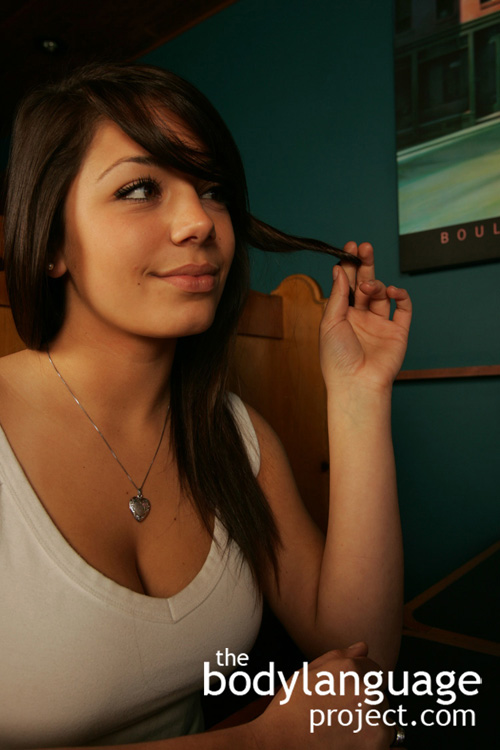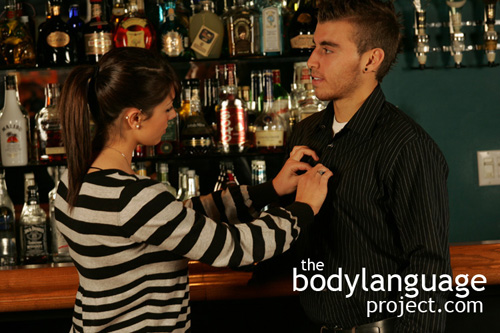Body Language of Hair Play
Synonym(s): Playing With The Hair, Twirling The Hair, Hair Tossing, Hair Flick, Sucking On The Hair, Combing The Hair, Brushing The Hair,,Sexual Hair Play, Running Fingers Through The Hair, Wrapping The Hair Around The Neck, Flicking The Hair, Hair Twirl, Hair Sucking.
Description: When hair is playing with, tossed, twirled, flicked, combed, or sucked.
In One Sentence: Playing with the hair is a sign of self grooming, pacifying, or is a way to draw attention to feminine features in a dating context.
How To Use it: Women can play with their hair in order to draw men’s attention to it. When hair is tossed and otherwise displaced, it will draw men’s eyes. Tossing, flicking, and brushing the hair are ways to display youthful qualities of fertility which is mostly unique to women.
Sucking on the hair or stroking the hair is also a way to help sooth nerves although it is not advisable to do so repetitively as it can be read by others as insecurity.
Context: a) Dating, b) General.
Verbal Translation: “I’m drawing attention to my hair by grooming it so that I can show off its luxuriousness and get it ready for other people’s eyes to feast upon its greatness.” “I’m concerned my hair is out of place so I’m fixing it so others don’t think I’m unkempt.” “I’m sucking on my hair to pacify myself as a replacement for a soother.”
Variant: See Head Toss.
Cue In Action: a) When she saw a cute boy she subconsciously twirled her hair around her finger, titled her head to the side and batted her eyes at him. b) During a boring lecture she passed the end of her long blonde hair through her lips to pacify herself. b) His hair was overgrown and it constantly fell into his eyes so he either flicked it away or brush it away with the side of his hand.
Meaning and/or Motivation: a) Hair tossing is done by women to show off their luxurious hair to men. Hair tosses can be done by flicking the hair over the shoulder or away from the face. Hair can be removed from a band and twirled or rolled and placed on top of the head to expose the neck.
Other hair signals include running the fingers through the hair to preen it, wrapping the hair around the neck or curling it around the finger. These types of signals are done by women usually out of their conscious awareness. They may be available and seeking sexual attention, but equally, they can be done to serve an actual function. When they are done to attract attention, they are driven by inner thoughts and desires which manifest as nonverbal cues. It is the desires that prime the motivation to act out sexually. In this case, grooming draws attention to her luscious hair and hence her youth and fertility.
Men will also preen in during courtship and might try to flatten their hair, stroke it, or brush it away from the eyes. In more overt cases, men might remove a comb and fix their hair entirely.
b) Outside of a dating context, the hair might be preened due to either a functional purpose such as when it blocks the vision, or as a means of pacifying. Sucking on the end of the hair is a replacement for a soother as it stimulates the sensitive lips. Running the fingers through the hair can also serve a pacifying purpose as it reminds us of having our hands entwined in someone else’s. Other times the hair is fussed with simply to preen and keep the hair in its place.
Cue Cluster: a) Added sexuality can come with a lip lick or moistening of the lips with lip gloss or adding lip stick to make them appear red and seductive. Having the lips slightly parted as if blowing a small stream of air through them can escalate the cues even more dramatically.
For hair play to be a sexual cue, it will be done in association with eye contact, absent of which might just be a form of soothing auto contact. Eye contact turns a fairly random gesture like touching the hair into one that is directional, meaning the eye contact sends a message to a person of interest.
Other times, women use signals to “fish and lure” where signals happen in a more broad-stroke fashion, absent of eye contact and direction, sent off into the room at large.
When men preen they will often do so secretly and will not use eye contact to draw attention to themselves. In other words, men will preen before an approach rather than during one as women tend to do.
Body Language Category: Adaptors, Amplifier, Auto contact or self touching, Boredom, Courtship display, Stroking body language, Indicators of sexual interest (IOsI), Pacifying, Preening, Worry body language.
Resources:
Abrahams, Matthewf.. Perceiving flirtatious communication: An exploration of the perceptual dimensions underlying judgments of flirtatiousness. Journal of Sex Research. 1994. 31(4): 283-292.
Cantor, Michael B. ; Smith, Stephen E. ; Bryan, Bonita R. Induced bad habits: Adjunctive ingestion and grooming in human subjects. Appetite. 1982. 3(1): 1-12.
Céline Jacob A, Nicolas Guéguen A and Christine Delfosse A. She Wore Something in Her Hair: The Effect of Ornamentation on Tipping. Journal of Hospitality Marketing And Management, 2012; 21: 414–420.
http://bodylanguageproject.com/articles/how-to-get-better-tips-wear-something-in-your-hair-says-research-research-on-tipping-behaviour-and-nonverbal-body-language/
Cameron C., S. Oskamp and W. Sparks. 1978. Courtship American style: newspaper advertisements. Family Coordinator 26: 27-30.
Clark, A. Attracting Interest: Dynamic Displays of Proceptivity Increase the Attractiveness of Men and Women. Evolutionary Psychology. 2008., 6(4), 563-574.
http://bodylanguageproject.com/articles/risky-versus-proceptive-nonverbal-sexual-cues/
Dreznick, Michaelt. ; Cronin, Josephm. ; Waterman, Carolinek. ; Glasheen, Cristie. Saying Yes when Meaning No: An Investigation of Gender and Individual Differences in Token Seduction. Journal of Psychology & Human Sexuality. 2003. 15(1): 69-84.
Dosmukhambetova, D., and Manstead, A. Strategic Reactions to Unfaithfulness: Female Self-Presentation in the Context of Mate Attraction is Link to Uncertainty of Paternity. Evolution and Human Behavior. 2011. 32, 106-107.
Fink, Bernhard; Nadine Hugill and Benjamin P. Lange. Women’s Body Movements Are a Potential Cue to Ovulation. Personality and Individual Differences. 2012. 53: 759-763.
http://bodylanguageproject.com/articles/women-use-sexier-body-language-indicate-ovulation-fertility-women-dance-walk-sexier/?preview=true
Fletcher, Garth J. O ; Kerr, Patrick S. G ; Li, Norman P ; Valentine, Katherine A. Predicting Romantic Interest and Decisions in the Very Early Stages of Mate Selection. Personality and Social Psychology Bulletin. 2014 40(4): 540-550.
Givens D. The nonverbal basis of attraction: Flirtation, courtship, and seduction. Psychiatry. 1978. 41: 346.
Grammer, Karl ; Kruck, Kirsten ; Juette, Astrid ; Fink, Bernhard. Non-verbal behavior as courtship signals: the role of control and choice in selecting partners. Evolution and Human Behavior. 2000. 21(6): 371-390.
Guéguen, Nicolas. Hair color and wages: Waitresses with Blond Hair Have More Fun. The Journal of Socio-Economics. 2012. 41: 370-372.
http://bodylanguageproject.com/articles/research-says-blondes-fair-better-tips-courtship-donations-spontaneous-helping/
Guéguen, Nicolas. Hair Color and Courtship: Blond Women Received More Courtship Solicitations and Redhead Men Received More Refusals. Psychol Stud. 2012. 57(4):369–375. DOI 10.1007/s12646-012-0158-6
Guéguen, Nicolas. Brief Report: Women’s Hair Color and Donations: Blonds Receive More Money. North American Journal of Psychology. 2011. 13(3): 367-372.
Guéguen, Nicolas. The Sweet Color of an Implicit Request: Women’s Hair Color and Spontaneous Helping Behavior. Social Behavior and Personality. 2012. 40(7): 1099-1102.
Goetz, Cari D.; Judith A. Easton; David M.G. Lewis; David M. Buss. Sexual Exploitability: Observable Cues And Their Link To Sexual Attraction. Evolution and Human Behavior. 2012; 33: 417-426.
http://bodylanguageproject.com/articles/victim-blaming-or-useful-information-in-preventing-rape-and-sexual-exploitation/
Goodboy, Alan, K. and Maria Brann. Flirtation Rejection Strategies: Towards an Understanding of Communicative Disinterest in Flirting. The Quantitative Report. 2010. 15(2): 268-278.
http://bodylanguageproject.com/articles/how-to-reject-flirting-using-nonverbal-and-verbal-tactics/
Hartfeil E. and S. Sprechler. 1986. Mirror, Mirror…The Importance of Looks in Everyday Life. State University of New York Press, Albany.
Hald, G. M., & Høgh-Olesen, H. Receptivity to Sexual Invitations from Strangers of the Opposite Gender. Evolution and Human Behavior. 2010. 31, 453-458.
Hinsz, V. B., D. C. Matz, and R. A. Patience 2001 Does Women’s Hair Signal Reproductive Potential? Journal of Experimental Social Psychology 37:166-172.
Hugill, Nadine ; Fink, Bernhard ; Neave, Nick. The role of human body movements in mate selection. Evolutionary psychology: an international journal of evolutionary approaches to psychology and behavior. 2010 8(1): 66-89.
Krumhuber, Eva; Antony S. R.; Manstead; and Arvid Kappas. Temporal Aspects of Facial Displays in Person and Expression Perception: The Effects of Smile Dynamics, Head-tilt, and Gender. Journal Nonverbal Behavior. 2007; 31: 39-56.
DOI 10.1007/s10919-006-0019-x
http://bodylanguageproject.com/articles/head-tilt-and-slow-onset-smile-nonverbals-trust-attraction-dominance-and-flirting-a-brief-report/
Kanazawa, S., & Still, M. C. (2000). Teaching may be hazardous to your marriage. Evolution and Human Behavior, 21, 185–190.
http://bodylanguageproject.com/articles/rival-good-body-language-makes-partner-look-uglier/
Mesko, Norbert ; Bereczkei, Tamas. Hairstyle as an adaptive means of displaying phenotypic quality. Human Nature. 2004. 15(3): 251-270.
Mishra, Sandeep; Andrew Clark and Martin Daly. One Woman’s Behavior Affects The Attractiveness Of Others. Evolution and Human Behavior. 2007 28: 145-149.
http://bodylanguageproject.com/articles/rival-good-body-language-makes-partner-look-uglier/
Miller, G., Tybur, J. M., & Jordan, B. D. Ovulatory cycle effects on tip earning by lap dancers: Economic evidence for human estrus. Evolution and Human Behavior. 2007. 28: 375-381. http://dx.doi.org/10.1016/j.evolhumbehav.2007.06.002.
Moore, Monica. M. Nonverbal Courtship Patterns in Women: Context and consequences. Ethology and Sociobiology. 1985. 6:237- 247.
Moore, M. M. Courtship Communication and Perception. Perceptual and Motor Skills. 2002. 94(1): 97-105. doi:10.2466/PMS.94.1.97-105.
Moore, M. M. and D. L. Butler. 1989. Predictive aspects of nonverbal courtship behavior in women. Semiotica 76(3/4): 205-215.
Moore, M. M. 2001. Flirting. In C. G. Waugh (Ed.) Let’s talk: A cognitive skills approach to interpersonal communication. Newark, Kendall-Hunt.
Moore, Monica. Courtship Signaling and Adolescents: Girls Just Wanna Have Fun. Journal of Sex Research. 1995. 32(4): 319-328.
http://bodylanguageproject.com/articles/girls-just-want-to-have-fun-the-origins-of-courtship-cues-in-girls-and-women/
Patton, Tracey Owens. Hey Girl, Am I More than My Hair?: African American Women and Their Struggles with Beauty, Body Image, and Hair. NWSA Journal. 2006. 18(2): 24-51.
Rosette, Ashleigh Shelby ; Dumas, Tracy L. The hair dilemma: conform to mainstream expectations or emphasize racial identity. Duke Journal of Gender Law & Policy. 2007. 14(1): 407(15).
Swami, Viren ; Barrett, Seishin. British men’s hair color preferences: An assessment of courtship solicitation and stimulus ratings. Scandinavian Journal of Psychology. 2011. 52(6): 595-600.
Singh, Devendra. Mating strategies of young women: Role of physical attractiveness. Journal of Sex Research. 2004. 41(1): 43-54.
Sorokowski, Piotr. Attractiveness of blonde women in evolutionary perspective: studies with two Polish samples. Perceptual and motor skills. 2008. 106(3): 737-44.
Thompson, Cheryl. Black Women, Beauty, and Hair as a Matter of Being. Women’s Studies. 2009. 38(8): 831-856.
Thompson, Kristin. Grooming the Naked Ape: Do Perceptions of Disease and Aggression Vulnerability Influence Grooming Behaviour in Humans? A Comparative Ethological Perspective. Current Psychology. 2010. 29(4): 288-296.
Rich, Melissa ; Cash, Thomas The American image of beauty: Media representations of hair color for four decades. Sex Roles. 1993. 29(1): 113-124.
Roberts – Grey, Gina. The root of health.(natural hair color offers surprising insights into your mental and physical well-being)(Report). Women’s Health. 2010. 080.
McAlexander, James, H. and John W. Schouten. 1989. Hair style changes as transition markers. Sociology and Social Research. 74: 58-62.
Synott, Anthony. 1987. Shame and glory: A sociology of hair. British Journal of Sociology. 38: 381-413.
Weitz, Rose. Women and Their Hair: Seeking Power through Resistance and Accommodation. Gender and Society. 2001 15(5): 667-686.
Watkins, Jessica L. and Jeffrey A. Hall. The Association Between Nonverbal
Sensitivity and Flirting Detection Accuracy. Communication Research Reports. 2014. 31(4): 348-356, DOI: 10.1080/08824096.2014.963220
http://bodylanguageproject.com/articles/men-women-detect-nonverbal-flirting-accurately/
Walsh, D. G., & Hewitt, J. (1985). Giving Men The Come-On: Effect Of Eye Contact And Smiling In A Bar Environment. Perceptual and Motor Skills, 61, 873-874.
Weerth, Carolina ; Kalma, Akko. Gender differences in awareness of courtship initiation tactics. Sex Roles. 1995. 32(11): 717-734.



